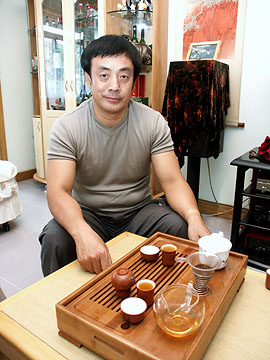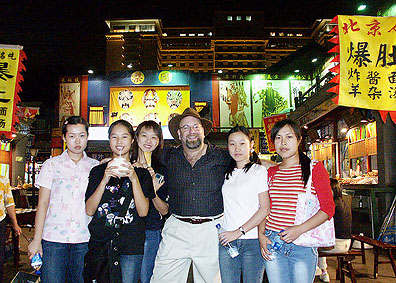
Mooncake, anyone?
The Road to China
Chapter 4: Moon Festival
|
Mooncake, anyone? |
September 11th was the day of the Moon Festival -- China's equivalent to the American Thanksgiving. It is a 4,000-year-old convergent holiday with several origins - it is at once a harvest festival, a commemoration of the overthrow of the Yuan dynasty, a family get together (the roundness of the moon symbolizes 'reunion' in China), and a celebration of ancient folklore. On Moon Festival night (also called Mid-Autumn festival), Chinese families get together to eat the moon cakes and watch the moon at night. Legend has it that these "moon cakes" (a very delicious stuffed cookie with fillings of sugar, fat, sesame, walnut, the yoke of preserved duck eggs, ham and I-don't-even-want-to-think-of-what-else) played an important role in the overthrow of the Yuan dynasty - instructions for an attack were baked inside and a successful overthrow of the government ensued, giving birth to the Ming dynasty (and perhaps also the fortune cookie). Moon cakes are hot sellers here a month before Moon festival, not unlike the plethora of pumpkins before Halloween. I received many as gifts from students and faculty on Teacher's day. (Yes, that's right, a cross-pollination of holidays - like giving a pumpkin on Christmas day.)
|
A painting made on silk. |
But wait! There's more. The ancient Chinese folklore aspect of the Moon festival, while impossible to convey in this short space, is connected to the blind bunny described in Chapter 3. Here's a synopsis, plagiarized directly from the web:
In this legend, three fairy sages transformed themselves into pitiful old men and begged for something to eat from a fox, a monkey and a rabbit. The fox and the monkey both had food to give to the old men, but the rabbit, empty-handed, offered his own flesh instead, jumping into a blazing fire to cook himself. The sages were so touched by the rabbit's sacrifice that they let him live in the Moon Palace where he became the "Jade Rabbit."
A very similar story has the rabbit skinning himself and offering his hide as a means for some guy named Jen Han to escape from the moon. It can be found at <http://www.humnet.ucla.edu/humnet/folklore/folk15/Gloria%20Chiang/folklore1>. Either way, the rabbit sacrificed himself to save someone else, and in light of that, the Poor Bunny is remembered annually. In light of this story, I guess the bunny in my globe was actually in pretty good shape.
 I had the pleasure and honor
of spending the Moon Festival evening with a local family. It was
here that I was treated to the experience of the "best tea in the
world", and the proper way to prepare and drink it.
I had the pleasure and honor
of spending the Moon Festival evening with a local family. It was
here that I was treated to the experience of the "best tea in the
world", and the proper way to prepare and drink it.
First you must understand that this is no ordinary tea! This is "Da Hoong Pau" tea, the most expensive tea in the world, and I was being taught by a self-proclaimed connoisseur of teas. Its leaves are harvested from one of four 300-year-old trees that grow on the side of the Wee Ee mountain in the South of China. There are miraculous myths of healing the sick associated with this tea. To give you an idea of just how expensive it is, one box of 250 g of tea leaves sells for more than USD $125. And the family I was with was by no means wealthy - this was, for them, simply an important priority.
A proper tea set is brought out, complete with a draining tray, two large pots, four tiny tea cups, and 4 very tiny crucibles for… well, I can't explain what they're for. But the process is like this:
1. First you must fill all the containers with hot water and give them a gentle rinse. This warms up the containers properly and gets rid of any residual dust. All of the washed utensils must be carefully handled with a special pair of tiny tongs.
2. You must smell the rich aroma of the tea leaves as they move from the box to an empty tea pot.
3. Fill the tea pot with hot water. It only needs to steep for about a minute - not long.
4. Pour tea into each of the four tiny crucibles.
5. Immediately place a tiny tea cup upside-down on top of the crucible, and quickly turn them both over so the tea is now in the teacup.
6. Take the now-empty crucible, roll it between your hands and take in the tea's lingering aroma that is still emanating from the crucible. (The crucible is still hot, of course, making this a nice activity during wintertime.)
7. Drink your cup of tea using no more than 3 sips, making as loud a "slurping" sound as you can to signify to all in the room that you are enjoying your tea very much.
I caught a cold the next day.
 I had heard stories about the
fascination with Westerners here, but I thought that would only be
in the countryside. Nope. Even in the most
westerner-infested part of Beijing, I still routinely get stopped
by people who either want to practice English, ask about life in
America, or just want to take a picture with a side-show
curiosity. I don't mind; it's a great way to network or to
just meet new friends.
I had heard stories about the
fascination with Westerners here, but I thought that would only be
in the countryside. Nope. Even in the most
westerner-infested part of Beijing, I still routinely get stopped
by people who either want to practice English, ask about life in
America, or just want to take a picture with a side-show
curiosity. I don't mind; it's a great way to network or to
just meet new friends.
A few days ago I learned that a bald head and a lot of body hair is revered here. Body hair I can understand because of the rarity, but bald people are a dime a dozen in China!! What's the deal? It turns out there is an old saying, "A crowded street has no grass." (Translation: "A clever head has no hair.") I can deal with that. And a note to people who like to keep score: yes, I've dropped some weight. Imagine what I'll be like when I return!!
 I don't watch much TV in the
states much anymore, but for some reason I've been going out of my
way to watch a lot of Chinese TV. I can divide the content into
three broad categories: News about bustling economic activity, epic
soap operas from a foregone dynasty, and hair care commercials,
reminding us all that true love can only be attained if you have
silky shiny hair and a giant softbox lighting it properly just
off-camera. And I'm convinced they only have about 30 different
commercials, because they keep showing the same ones over and over,
sometimes the same one 6 times in a row. My guess is either they
couldn't sell all the advertising space, or they took a lesson from
Madison Ave. and decided that repetition really is a good thing
when it comes to establishing brand awareness.
I don't watch much TV in the
states much anymore, but for some reason I've been going out of my
way to watch a lot of Chinese TV. I can divide the content into
three broad categories: News about bustling economic activity, epic
soap operas from a foregone dynasty, and hair care commercials,
reminding us all that true love can only be attained if you have
silky shiny hair and a giant softbox lighting it properly just
off-camera. And I'm convinced they only have about 30 different
commercials, because they keep showing the same ones over and over,
sometimes the same one 6 times in a row. My guess is either they
couldn't sell all the advertising space, or they took a lesson from
Madison Ave. and decided that repetition really is a good thing
when it comes to establishing brand awareness.
|
An outdoor pedestrian mall at night. |
Chinese music doesn't suffer from such lack of variety. Although there is relatively little hip-hop or rap music here (by choice; not by censorship); the airwaves here are filled with a mix of classical and modern Chinese music, all of which, as a whole, is the most beautiful music one can hear on any continent. About the only American artists that I encounter consistently are the Back Street Boys, N Sync, and Karen Carpenter (who is insanely popular, even now).
Until next time...
"Yours Truly, Gary Friedman"
September 16, 2003
Return to The Friedman Archives Home Page